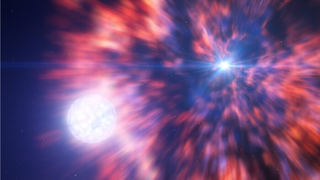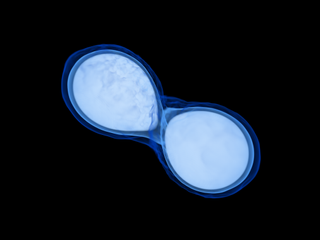When it comes to “smashing” the universe’s ghosts, only the most extreme things in the universe can be up to the task: neutron stars.
Scientists have performed simulations of collisions between these energetic and dead stars, showing that such energetic events may be capable of briefly “capturing” neutrinos, known as “ghost particles.” The discovery could help scientists better understand neutron star mergers in general, which are events that create an environment turbulent enough to form objects heavier than iron. Such elements cannot even be formed in the hearts of stars – and this includes gold on your finger and silver on your neck.
Neutrinos are considered the “ghosts” of the particle zoo due to their lack of charge and very small mass. These properties mean that it rarely interacts with matter. To put that into perspective, as you read this sentence, over 100 trillion neutrinos are streaming through your body at nearly the speed of light, and you can’t feel a thing.
This new simulation of the merger of neutron stars was carried out by Penn State University physicists, and it finally showed that the place where these dead stars meet (the interface) becomes very hot and dense. In fact, it becomes strong enough to capture a group of “world spirits.”
At least for a while, anyway.
Despite their lack of interaction with matter, the neutrinos created in the collision would be trapped at the neutron-star fusion interface and become hotter than the relatively cool hearts of colliding dead stars.
Related: James Webb space telescope finds merger of neutron stars and gold in space: ‘It was exciting’
This is known as neutrinos being “out of thermal equilibrium” with the cold particles of the neutron star. During this warm-up phase, which lasts about two to three milliseconds, the team’s simulations showed neutrinos can interact with and fuse the material of the neutron star, in turn helping to restore thermal equilibrium.
“Neutron stars before fusion are cold. Although they can be billions of degrees, Kelvin, their incredible density means that this heat contributes very little to the energy of the system,” said team leader David Radice, assistant professor of physics, astronomy. and astronomy at Penn State’s Eberly College of Science, it said in a statement. “When they collide, they can be very hot. The interface of colliding stars can be heated up to trillions of degrees Kelvin. However, it is so dense that photons cannot escape to dissipate the heat; instead, we think they fight. Cool by emitting neutrinos.”
To set traps for the spirit of the world
Neutron stars are born when a massive star with at least eight times the mass of the Sun runs out of the fuel needed for nuclear fusion in its core. After that fuel supply runs out, the star can no longer support itself against the inward thrust of its own gravity.
This starts a series of primary folds that lead to the fusion of the heavier elements, which they buy. even heavy elements. This cycle ends when the core of a dying star is filled with iron, the heaviest element that can form in the core of a massive star. Then, the gravitational collapse occurs again, causing a supernova explosion that blasts the outer layers of the star and its mass.
Rather than creating new elements, this final collapse creates a completely new unique state for the interiors of neutron stars. Negative electrons and positive protons are forced together, creating an ultradense soup of neutrons, which are neutral particles. A feature of quantum physics called “vacuum pressure” prevents these neutron-rich particles from collapsing further, although this can be overcome by stars of sufficient mass that they collapse completely – to the point of giving birth to black holes.

The result of this series of collapses is a dense dead star, or neutron star, with between one and two times the mass of the original star – packed into a mass of about 12 miles (20 km). For context, the matter that comprises neutron stars is so dense that if a spoonful of it were brought to Earth, it would weigh as much as Mount Everest. Maybe more.
These super stars don’t always live (or die) in isolation, however. Some binary star systems have two stars large enough to give birth to neutron stars. As these binary neutron stars orbit each other, they emit waves in space and time called gravitational waves.
When these gravitational waves return from neutron star pairs, they carry angular momentum. This causes a loss of orbital energy in the binary causing the neutron stars to move together. The faster they spin, the faster they emit gravitational waves – and the faster their orbits tighten. Eventually, the mass of neutron stars takes over, and the dead stars collide and merge.
This collision creates “neutrons” of neutrons, enriching the environment around the fusion with free releases of these particles. These can be “captured” by the atoms of the elements in this environment during a phenomenon called “rapid capture process” (r-process) . This creates heavier elements that decay with radiation to form lighter elements that are still heavier than metal. Consider gold, silver, platinum, and uranium. The decay of these elements also causes an explosion of light astronomers call “kilonova.”
The first moments of neutron star collisions
Neutrinos are also created during the first moments of a neutron star’s merger as neutrons disintegrate, the team says, creating electrons and protons. And the researchers wanted to know what might happen in these early times. To get some answers, they created simulations that use massive amounts of computing power to simulate neutron star mergers and the physics associated with such events.

The Penn State team’s simulations revealed for the first time that, for short periods of time, the heat and density generated by a neutron star collision is enough to trap even neutrinos, which otherwise have earned their mythical nicknames.
“These extreme events stretch the boundaries of our understanding of physics, and studying them allows us to learn new things,” Radice added. “The period when the merging stars are out of alignment is only two to three milliseconds, but just like the temperature, time is consistent here; the orbital period of the two stars before merging can be as little as one millisecond.
“This brief out-of-equilibrium phase is where the most interesting physics occurs. Once the system returns to equilibrium, the physics is well understood.”
The team thinks the precise physical interactions that occur during neutron star mergers can affect the light waves from these powerful events that can be observed on Earth.
“How the neutrinos interact with the matter of the star and are finally released can affect the rotation of the combined remnants of the two stars, which can affect how the electromagnetic and gravitational wave signals of the merger appear when they reach us here on Earth,” team member Pedro Luis Espino, researcher postdoctoral fellow at Penn State and the University of California, Berkeley, said in the statement. “Next-generation gravitational wave detectors can be designed to look for these types of wave variations. In this way, these simulations play an important role, enabling us to gain insight into these extreme events while informing future experiments and observations in certain types of events. feedback loop.
“There is no way to reproduce these events in the laboratory to study them experimentally, so the best window we have to understand what happens during a neutron star merger is through the mathematical simulations that come from Einstein’s theory of general relativity.”
The team’s research was published May 20 in the journal Physical Review Letters.
#Neutron #star #collisions #capture #fleet #cosmic #ghosts #short #period #time